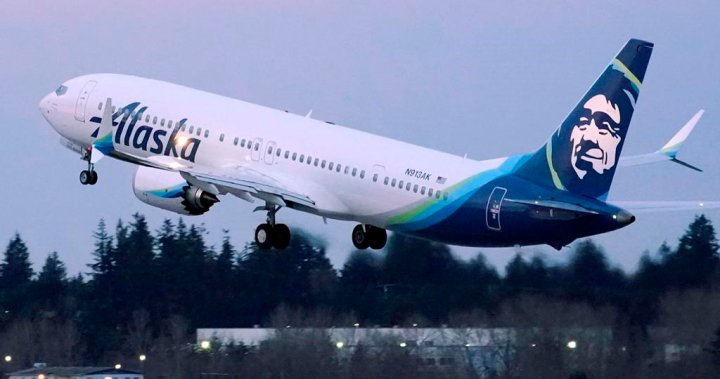General News
Scared to fly after recent aviation incidents? How to combat your fears – National

As inspections continue into the door plugs of Boeing 737 Max 9 aircraft following a blowout incident on an Alaska Airlines plane Friday, there may be air travellers preparing for a journey who are feeling nervous or even fearful of flying.
But psychologists say there are ways to combat a fear that isn’t always directly to do with flying itself.
A fear of flying, also known as aviophobia, is not rare — in fact, in the U.S., it’s one of the most common, with the National Institute of Mental Health estimating 2.5 to 6.5 per cent having this worry in varying levels. In some cases, people may even avoid flying because of the concern. There is no current data on aviophobia reported in Canada as of publication.
“It’s really about how people deal with their own stuff, their own feelings, their own thoughts, their own experiences that they have internally,” Ian Shulman, a clinical psychologist at Shift Cognitive Therapy + Assessment in Oakville, Ont., told Global News.
He said it often can revolve around our feeling of a lack of control once we board the plane. In some aspects of life, such as driving a vehicle or even going to the dentist, there are options people can take, such as pulling off the road if you get nervous or taking care of your teeth so you can avoid dental visits.
When it comes to a plane, however, once you board and take off, you’re on the flight for its duration and are not in control.
“It forces us to sit with our own stuff and if people are more in the habit of avoiding their own stuff, their own thoughts, their own feelings, their own histories and scars and wounds and things like that, then of course they’re going to struggle,” he said. “The flying takes away … that idea, whether it’s accurate or not, that I don’t ever have to deal with this stuff. I can avoid it, I can distract myself. Well, you can’t really when you’re on a plane.”
And when events like the Alaska Airlines incident or last week’s collision between a Japan Airlines plane and another aircraft occur, Shulman notes the brain starts to populate with similar events that have happened.
“We lose track of all of the facts that there are hundreds of thousands, probably millions, for sure millions of other flights that happen,” he said. “We just end up kind of stitching together all those four or five or six instances as if that is the only thing that ever happens, and it really isn’t.”
But while some people may point to recent airline incidents as a cause of their fear, statistics still show flying as a reliably safe way to travel.

In Canada just last year, the Transportation Safety Board recorded 24 fatal air transportation accidents resulting in 34 deaths, but the TSB said none of the deaths involved airliner or commuter operations. The majority were linked to privately registered aircraft, while three involved air taxi regulations, six were under aerial work regulations and one was under flight training unit regulations. In terms of injuries, there were three in airliners; however, none occurred in a commuter aircraft.
Get the latest National news.
Sent to your email, every day.
These numbers are minimal in comparison to the 995 rail incidents that occurred in 2022, though the TSB notes about 318 involved freight trains, 54 were passenger trains and approximately 627 involved what the TSB said were mainly single cars, locomotives and track units. In terms of deaths, there were 66, with 14 from crossing and 52 from trespassing.
Though no data is currently available from Transport Canada on 2022 reportable motor vehicle collisions as of publication, data for 2021 shows there were 1,768 deaths, with 108,018 total injuries. It should be noted, however, that this number includes pedestrian, bicyclist and motorcyclist deaths, but of those involving drivers and passengers, there were still 1,151 fatalities.
Meanwhile, in the U.S., the National Safety Council estimated there were 21,130 motor vehicle deaths in just the first six months of 2023, while globally there were just two fatal incidents in which propeller aircraft came down on domestic flights, resulting in 86 deaths.
According to the World Health Organization, a total of 1.19 million people die each year as a result of road traffic crashes.
How to combat fears around flying
Former airline captain and licensed therapist Tom Bunn said the fear can at times be a result of traumatic experiences slowly changing how our brain experiences not being in control.
Even with statistics showing the safety of flying, he notes stress hormones may in some cases cause people to lose track of the rational.

“How do you keep from getting the stress hormones (wiping) your ability to think? We have to train the mind to automatically respond when you get the feeling of alarm,” he told Global News in an interview. “What’s supposed to happen when alarm happens, it’s supposed to grab our attention and then we’re supposed to have our calming system immediately kick in so we can think clearly.”
Bunn founded the company SOAR in 1982 with the aim of providing a program that could help anyone who needed it find ways to combat that fear of flying and the associated issues with it such as anxiety. He said through working with patients, one way to combat this alarm is to find people — friends, family — who keep you calm to help activate that calming system.
But people are not always travelling with those loved ones, so both Bunn and Shulman suggest speaking with a variety of people who could help.
Bunn said if you arrive early to your gate, there is always a chance you may be able to speak with airline staff who might even be able to introduce you to your plane’s captain, which could help.

“Just having a few seconds to just meet the person who’s in charge of your safety can help you feel much more comfortable about being in that situation,” he said.
Even if you can’t meet the captain, there are other options once on board the plane. Shulman said this can include speaking with the cabin crew, who can potentially help passengers feeling nervous about flying, or even speaking with your fellow passengers and asking if you can speak with them when going through a period of nervousness.
“Going through difficult things is not comfortable, but going through difficult things and feeling like we’re really alone or like we’re going to get judged for it or criticized,” Shulman said, “that’s even worse.”
Source
Disclaimer: No copyright infringement intended. All rights and credits reserved to respective owner(s).


























